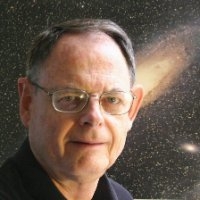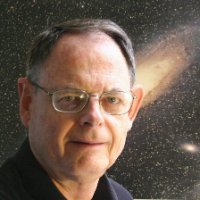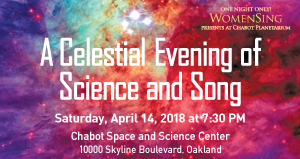
 WomenSing is pleased to introduce Astronomer Gerald McKeegan, who will be giving the planetarium presentation at our Chabot event on April 14. Gerald has been interested in astronomy since he was a child. He holds a Master of Science Degree in Space Studies, and has 40 years experience working in the space industry. Gerald’s career includes work on communication satellites, science satellites, and launch vehicles.
WomenSing is pleased to introduce Astronomer Gerald McKeegan, who will be giving the planetarium presentation at our Chabot event on April 14. Gerald has been interested in astronomy since he was a child. He holds a Master of Science Degree in Space Studies, and has 40 years experience working in the space industry. Gerald’s career includes work on communication satellites, science satellites, and launch vehicles.
Most of the satellites Gerald worked on were communication satellites. There are at least two hundred of this type of satellite in the Earth’s orbit. Additionally, Gerald worked on Gravity Probe B, a NASA physics mission which orbited 400 miles above Earth investigating two key aspects of Einstein’s general theory of relativity.
 In addition to satellites placed in Earth’s orbit, Gerald has worked on far-reaching NASA missions, including the Cassini mission, an international scientific mission to Saturn launched in 1997. The Cassini carried a high-tech data disk that contained the signatures of all those who worked on the mission, including Gerald’s (Click HERE to learn more.)! One of Cassini’s key discoveries was the global ocean on Saturn’s moon, Enceladus (Click HERE for more details). The Cassini also sent back evidence of hydrothermal vents on Enceladus, something found on Earth which is thought by many scientists to be the origin of life on Earth (Want to know more? Click HERE).
In addition to satellites placed in Earth’s orbit, Gerald has worked on far-reaching NASA missions, including the Cassini mission, an international scientific mission to Saturn launched in 1997. The Cassini carried a high-tech data disk that contained the signatures of all those who worked on the mission, including Gerald’s (Click HERE to learn more.)! One of Cassini’s key discoveries was the global ocean on Saturn’s moon, Enceladus (Click HERE for more details). The Cassini also sent back evidence of hydrothermal vents on Enceladus, something found on Earth which is thought by many scientists to be the origin of life on Earth (Want to know more? Click HERE).
 The New Horizons Mission is another one of Gerald’s more distant projects. Launched on January 19, 2006, this mission conducted a six month reconnaissance fly-by study of Pluto and its moons seeking to understand how Pluto and its moons “fit in” with the inner rocky planets and outer gas giants in our solar system (Click HERE for the full article.).
The New Horizons Mission is another one of Gerald’s more distant projects. Launched on January 19, 2006, this mission conducted a six month reconnaissance fly-by study of Pluto and its moons seeking to understand how Pluto and its moons “fit in” with the inner rocky planets and outer gas giants in our solar system (Click HERE for the full article.).
Back here on Earth, at Chabot, in addition to running planetarium shows, Gerald is also a telescope operator and the principal investigator in the asteroid search program. The asteroid search program uses a global network of observatories to track asteroids, determine their orbit, and project their future trajectory to determine whether they are a threat to Earth. It also identifies and catalogs newly discovered asteroids. There are over 17,000 asteroids cataloged so far that have come close to or crossed Earth’s orbit!
One aspect of astronomy that particularly appeals to Gerald is that one cannot measure certain things directly. Rather one must use detective work to expand one’s understanding. Astronomers will come up with a theory and then look for phenomena to confirm their theory. The science of astronomy is, therefore, confined to what one can see. Gerald used the temperature of stars as an example. He explained that we know the temperature of stars because of their colors. Specifically, stars are made of gas and we know that certain gasses at certain temperatures emit certain colors. You cannot measure the temperature of stars directly, but this sort of detective work gets you to the answer.
At WomenSing’s “A Celestial Evening of Science and Song” event, Gerald will give a planetarium presentation entitled “The Lion’s Lair: A Safari in the Spring Sky”. He will talk about basic astronomy and the constellations in the spring sky, of which Leo (the lion) is prominent in April. Gerald also will take questions posed by our audience.









